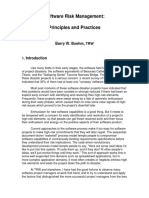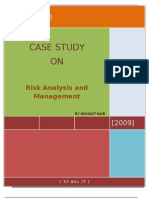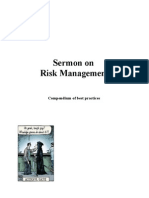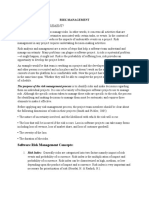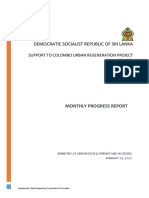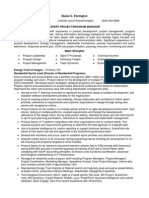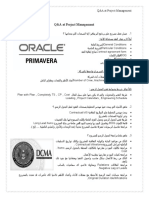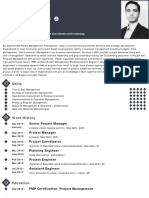7 Risk MGT
7 Risk MGT
Uploaded by
Lakshmi Narayanan Peter PaulCopyright:
Available Formats
7 Risk MGT
7 Risk MGT
Uploaded by
Lakshmi Narayanan Peter PaulOriginal Title
Copyright
Available Formats
Share this document
Did you find this document useful?
Is this content inappropriate?
Copyright:
Available Formats
7 Risk MGT
7 Risk MGT
Uploaded by
Lakshmi Narayanan Peter PaulCopyright:
Available Formats
1
INSTRUCTORS RESOURCE MANUAL
CHAPTER SEVEN
Risk Management
1.Do you agree with the following
statement: With proper planning it is
possible to eliminate most/all risks from a
project. Why or why not?
2.In evaluating projects across industries, it
is sometimes possible to detect patterns in
terms of the more common types of risks
they routinely face. Consider the
development of a new software product
and compare it to coordinating an event,
such as a school dance. What likely forms
Copyright 2010 Pearson Education, Inc. Publishing as Prentice Hall
of risk would your project team face in
either of these circumstances?
3.Analyze Figure 7.2 (degree of risk over
the project life cycle). What is the
practical significance of this model?
What implications does it suggest for
managing risk?
4.What are the benefits and drawbacks of
using the various forms of risk
identification mentioned in the chapter
(e.g., brainstorming meetings, expert
opinion, etc.)?
5.What are the benefits and drawbacks of
using a qualitative risk assessment matrix
for classifying the various types of project
risk?
Copyright 2010 Pearson Education, Inc. Publishing as Prentice Hall
6.What are the benefits and drawbacks of
using a quantitative risk assessment tool
such as the one shown in the chapter?
7.Give some examples of projects using
each of the risk mitigation strategies
(accept, minimize, share, or transfer).
How successful were these strategies? In
hindsight, would another approach have
been better?
8.Explain the difference between
managerial contingency and task
contingency?
9.What are the advantages of developing
and using a systematic risk management
approach, such as PRAMs methodology?
Do you perceive any disadvantages with
this approach?
Copyright 2010 Pearson Education, Inc. Publishing as Prentice Hall
10. Consider the following statement: The
problem with risk analysis is that it is
possible to imagine virtually anything going
wrong on a project. Where do you draw
the line; in other words, how far do you
take risk analysis before it becomes
overkill? How would you respond to this
observation?
CHAPTER SEVEN
PROJECT PROFILE Project Moses: Keeping Venice Above Water
INTRODUCTION
PROJECT MANAGERS IN PRACTICE Mohammed Al-Sadiq, Aramco Oil Company
7.1 RISK MANAGEMENT: A FOUR-STAGE PROCESS
Risk Identification
Analysis of Probability and Consequences
Risk Mitigation Strategies
Use of Contingency Reserves
Other Mitigation Strategies
Control and Documentation
PROJECT PROFILE Ferris Wheels: Bigger and Higher
Copyright 2010 Pearson Education, Inc. Publishing as Prentice Hall
7.2 PROJECT RISK MANAGEMENT AN INTEGRATED APPROACH
Summary
Key Terms
Solved Problems
Discussion Questions
Problems
Case Study 7.1: DeHavillands Falling Comet
Case Study 7.2: Tacoma Narrows Bridge
Integrated Project Project Risk Assessment
Internet Exercises
PMP Certification Exam Questions
Bibliography
Copyright 2010 Pearson Education, Inc. Publishing as Prentice Hall
TRANSPARENCIES
7.1
RISK VERSUS AMOUNT AT STAKE
Copyright 2010 Pearson Education, Inc. Publishing as Prentice Hall
7.2 TYPICAL RISK FACTORS
1. FINANCIAL RISKS
2. TECHNICAL RISKS
3. COMMERCIAL RISKS
4. EXECUTION RISKS
5. CONTRACTUAL OR LEGAL RISKS
Copyright 2010 Pearson Education, Inc. Publishing as Prentice Hall
7.3 QUALITATIVE RISK ASSESSMENT MATRIX
Copyright 2010 Pearson Education, Inc. Publishing as Prentice Hall
7.4 QUANTITATIVE RISK ASSESSMENT
CALCULATIONS
Copyright 2010 Pearson Education, Inc. Publishing as Prentice Hall
10
7.4 QUANTITATIVE RISK ASSESSMENT
CALCULATIONS (COND)
Copyright 2010 Pearson Education, Inc. Publishing as Prentice Hall
11
7.4 QUANTITATIVE RISK ASSESSMENT
CALCULATIONS (COND)
Copyright 2010 Pearson Education, Inc. Publishing as Prentice Hall
12
7.5 CONTINGENCY DOCUMENT FOR ADJUSTMENTS
TO PROJECT PLAN
Probable
Event
ADJUSTMENT TO PLANS
Absenteesim
Resignation
Pull-aways
Unavailable
Staff/skills
Spec Change
Added work
Need more
training
Vendors late
Copyright 2010 Pearson Education, Inc. Publishing as Prentice Hall
13
DISCUSSION QUESTIONS
10.
Do you agree with the following
statement: With proper planning it is
possible to eliminate most/all risks from a
project. Why or why not?
It is not possible to eliminate risk from a project
regardless of planning. The role of risk
management is to identify and analyze potential
risks associated with a project. Once risks have
been identified, preventative action or
contingency plans may be established to reduce
the impact of the risk on the success of the
project. While this presents a way to help
control the effects of risk, it does not eliminate
risk from the project management equation.
Copyright 2010 Pearson Education, Inc. Publishing as Prentice Hall
14
11.
In evaluating projects across industries,
it is sometimes possible to detect patterns in
terms of the more common types of risks
they routinely face. Consider the
development of a new software product and
compare it to coordinating an event, such as
a school dance. What likely forms of risk
would your project team face in either of
these circumstances?
A new software product would include a higher
amount of risk than a school dance. The
software project would be subject to risk related
to market volume/price, technical risk,
financing, scheduling, resignation,
organizational, and operating risk. Coordinating
Copyright 2010 Pearson Education, Inc. Publishing as Prentice Hall
15
a school dance would run risks associated with
availability of staff and an appropriate facility as
well as adequate funding. Both projects would
involve risk variables such as cost estimate risk,
integration risk, acts of God, inadequate skills
availability, and absenteeism.
12.
Analyze Figure 7.2 (degree of risk over
the project life cycle). What is the practical
significance of this model? What
implications does it suggest for managing
risk?
The diagram demonstrates the relationship
between level of opportunity and risk throughout
the project life cycle. This is helpful in
Copyright 2010 Pearson Education, Inc. Publishing as Prentice Hall
16
determining points at which uncertainty is at its
highest and when the greatest amount of risk
may be realized. Project teams can focus their
risk analysis in these areas or use the diagram to
give weight or perspective to potential risk
variables. The diagram also depicts the riskreward (opportunity) trade off for various stages
of a project. Managers can use this information
to determine if risk at a certain point is worth the
potential payoffs.
13.
What are the benefits and drawbacks of
using the various forms of risk identification
mentioned in the chapter (e.g.,
brainstorming meetings, expert opinion,
etc.)?
Copyright 2010 Pearson Education, Inc. Publishing as Prentice Hall
17
Brainstorming, expert opinion and multiple
assessment approaches share similar benefits
and drawbacks. The benefits include a variety
of experience and multiple angles of analysis
due to different points of view and areas of
expertise. Synergy among group members may
also create a wider range of risk identification.
Although there are shortcomings to these
approaches. It may be difficult to come to an
agreement or consensus in such processes due to
conflicting opinions and personal issues.
Brainstorming, expert opinion (when performed
in a forum setting rather than through the Delphi
approach) and multiple assessments may also
have difficulty reaching consensus due to
egos/authority issues and functional biases
Copyright 2010 Pearson Education, Inc. Publishing as Prentice Hall
18
(when members of different departments are
present). When the Delphi technique is
employed many of these issues are resolved
because members do not meet face-to-face. The
process becomes anonymous reducing
interference of egos and personal problems.
However, the Delphi approach can take
considerable time to complete successfully.
Past history is a unique approach to the other
three. It uses historical facts to reach
conclusions, which removes many obstacles that
the other techniques encounter. The benefits of
risk identification through past history is that, if
past projects were well documented, information
related to similar projects can easily be found
and project teams can avoid pitfalls by learning
Copyright 2010 Pearson Education, Inc. Publishing as Prentice Hall
19
from the mistakes of others. Unfortunately, the
drawback is that past performance does not
always predict future performance. Projectspecific data (i.e. competitive environment,
economy, etc.) is unaccounted for. Thus, past
history may do little to forecast present risks.
14.
What are the benefits and drawbacks of
using a qualitative risk assessment matrix
for classifying the various types of project
risk?
Qualitative risk assessment matrix is beneficial
in providing a visual depiction of potential risk
factors. The matrix enables the project team to
prioritize risk based on severity of consequences
Copyright 2010 Pearson Education, Inc. Publishing as Prentice Hall
20
and likelihood of occurrence. For instance,
those that rest in the high portion of both
consequences and likelihood would be top
priorities during project planning. Drawbacks of
the matrix may revolve around differences in
opinion as to where risk variables should be
placed on the matrix. It may also create tunnel
vision where the team fails to acknowledge the
significance of tasks that fall outside of the high
priority areas.
15.
What are the benefits and drawbacks of
using a quantitative risk assessment tool
such as the one shown in the chapter?
Copyright 2010 Pearson Education, Inc. Publishing as Prentice Hall
21
One benefit of such tools is in the ability to set
thresholds based on calculations of probability
and consequence. A numerical point system
creates an easy way to compare different risk
variables. This point system also provides more
detail than a matrix in depicting the level of risk.
Additionally, once the point system is designed
it can be used over and over to compare risk
factors of future projects. Problems with these
tools may arise in disagreement over assigning
points and creating thresholds. Also, the point
system is not an exact science. It relies on rules
of thumb and may be subject to interpretation.
16.
Give some examples of projects using
each of the risk mitigation strategies (accept,
Copyright 2010 Pearson Education, Inc. Publishing as Prentice Hall
22
minimize, share, or transfer). How
successful were these strategies? In
hindsight, would another approach have
been better?
This question requires students to do some
online research, investigating projects and
analyzing them in terms of various risk
mitigation approaches. One suggestion is to
assign a specific project, such as the new Airbus
A-380 and have the students research it, address
relevant risks factors, and the mitigation
strategies the company employed.
Copyright 2010 Pearson Education, Inc. Publishing as Prentice Hall
23
17.
Explain the difference between
managerial contingency and task
contingency?
Contingency reserves are provisions set aside in
case of unforeseen problems. The primary
differences between task and managerial
contingency are that managerial contingency is
applied at the project level while task
contingency is applied at the individual task or
work package level. Managerial contingencies
are budgeting buffers that teams can fall back on
in case of natural disasters, severe divergence
from original process or technical plans or other
acts of God. Task contingencies are
established because estimates (made during
initial planning) for individual tasks may be
Copyright 2010 Pearson Education, Inc. Publishing as Prentice Hall
24
unreliable. Reserves for these contingencies
may be adjusted as the project advances and
estimates become more accurate.
18.
What are the advantages of developing
and using a systematic risk management
approach, such as PRAMs methodology?
Do you perceive any disadvantages with this
approach?
PRAMs and other similar systems are
advantageous because they provide a detailed
step-by-step approach to risk management. This
helps project teams work through each part of
risk management effectively before moving on
to subsequent tasks. This way the team does not
Copyright 2010 Pearson Education, Inc. Publishing as Prentice Hall
25
get stalled at one stage or leave out a vital step
altogether. PRAMs adds an additional feature
the feedback loop that acts as a built-in
safeguard to overlooking risk associated with
project changes. The loop also keeps varying
levels of managers and team members up-todate on project and risk adjustments. The
disadvantage to the PRAMs model is that it may
be too involved for low-budget or otherwise
small projects. The amount of time required to
learn and institute the steps may be unreasonable
in a short-term, low-budget initiative. Also, it
may not be feasible for smaller companies who
do not have the resources or time to devote to
such a system.
Copyright 2010 Pearson Education, Inc. Publishing as Prentice Hall
26
10. Consider the following statement: The
problem with risk analysis is that it is possible
to imagine virtually anything going wrong on
a project. Where do you draw the line; in
other words, how far do you take risk analysis
before it becomes overkill? How would you
respond to this observation?
The tools in this chapter address this very
problem. Looking for possible risks could be an
endless process, however, it is important (as
outlined in the text) to approach risk in a
systematic way. The early stages of risk
management may best answer this question.
The prioritization of risks makes the process
manageable, and when done properly, will
prevent a situation of overkill. After potential
Copyright 2010 Pearson Education, Inc. Publishing as Prentice Hall
27
risks have been identified (using a supervised,
controlled method such as brainstorming, expert
opinion, etc.), managers can use qualitative and
quantitative tools to sift through scores of risks
to identify what is probable enough to worry
about. Once vital risk variables have been
identified, then mitigation and contingencies can
be established. This process does not ensure that
all risks will be identified or that the right
contingencies will be created. All the same, the
benefits of taking part in risk management far
outweigh the danger of not preparing for
potential problems.
CASE STUDIES
Case Study 7.1: DeHavillands Falling Comet
Copyright 2010 Pearson Education, Inc. Publishing as Prentice Hall
28
The DeHavilland story is a fascinating example of a well-respected organization that
sought to be first to market with a radical new technology and cut some important safety
corners, with disastrous results. The story highlights the problems when innovations in
design are pushed too far, too quickly. With its unique design and all the additional
features that made it radical, the Comet should have been slowly integrated into
production and use, instead of being rushed to market. DeHavilland knew that Boeing
was at work on its own design, the 707, and felt the need to be first to market. In this
rush, they cut a number of safety corners with disastrous results.
Questions:
1) How could risk management have aided in the development of the Comet?
DeHavilland was producing an aircraft that was so revolutionary in so many ways that
they may have become overawed by the push in technology for its own sake. Certainly,
the original Comet included several radical design elements (embedded engines in the
wing root, square windows, pressurized cabin, and so forth) that any one of them could
have been a significant advance on its own. Putting them all together into the same new
aircraft design without adequate testing was a disaster. The question of how much testing
is enough is difficult to answer but certainly, with so many innovations in one design, it is
clear that they did not engage in sufficient risk assessment and design testing.
2) Discuss the various types of risk (technical, financial, commercial, etc.) in relation
to the Comet. Develop a qualitative risk matrix for these risk factors and assess
them in terms of probability and consequences.
This question asks students to identify the wide variety of risks that were present in this
aircraft. Commercially, DeHavilland had a huge investment in its success and perceived
that first-mover advantage would allow them to pick up a big piece of the commercial jet
aircraft market if they were first off the mark. Technically, the aircraft had so many new
and radical features that several of them could have been perceived as risky in their own
Copyright 2010 Pearson Education, Inc. Publishing as Prentice Hall
29
right. All of them together were simply too much risk, too fast. Although in might be
difficult for students to reasonably comment on probability of failure, there is no question
that consequences would be catastrophic (as they were).
3) Given that a modified version of the Comet (the Comet IV) is still in use with the
British Government as an anti-submarine warfare aircraft, it is clear that the
design flaws could have been corrected given enough time. What, then, do you
see as DeHavillands critical error in the development of the Comet?
Over time, the fundamental aircraft design (minus the original square windows) has been
proven to be a success, though the company never again attempted to launch it in the
commercial jet market. DeHavilland tried to do too much too fast and created an unsafe
design due to inadequate testing. Students are quick to recognize this basic error on
DeHavillands part. It is often instructive to note that this foray into the commercial jet
aircraft market was DeHavillands last and they never returned to the level of technical or
commercial success they had enjoyed during and just after the Second World War.
4) Comment on the statement: Failure is the price we pay for technological
advancement.
This question can generate several opinions from students as evidence demonstrates
again and again that organizations continue to push the edges of the technological
envelope with new designs for buildings, aircraft, automobiles, etc. The issue that we
have to address is just how far one should be allowed to push this envelope and at what
point does some system of controls come into play. Clearly, the greater the consequences
of failure, the greater the oversight needed to ensure that sufficient risk analysis and
management has taken place prior to opening Pandoras Box.
Case Study 7.2: Tacoma Narrows Bridge
Copyright 2010 Pearson Education, Inc. Publishing as Prentice Hall
30
The famous story of the bridge that shook itself to pieces is familiar to many students.
The background of the story is not as well known and illustrates what happens when we
attempt to be too innovative without recognizing the full implications of our choices.
The Tacoma Narrows Bridge (TNB) was built at a sight with numerous design challenges
and difficulties, including physical location, size and length of the bridge, use of nonoptimal materials, and so forth. From a risk analysis perspective, the TNB represents
another example of journeying too far into the unknown and only belatedly recognizing
the implications of major design decisions.
Questions:
1) In what ways was the projects planning and scope management appropriate and
when did they begin taking unknowing or unnecessary risks? Discuss the issue of
project constraints and other unique aspects of the bridge in the risk management
process. Did they take them sufficiently into consideration? Why or why not?
It is easy, in hindsight, for students to criticize several elements in the TNB development
and construction; however, it is important that instructors not allow them to take the easy
way out and focus on the result of the construction. Rather, it is useful to examine how
the development of this bridge actually led to the understanding of an entirely new field
of engineering aerodynamics. It was thought, up to that point, that bridge-building was
simply a static engineering problem, concerned with downward loads. It took this failure
for engineers and scientists to understand the implications of entirely new forces. In
developing the answers to this question, it is useful to consider all the constraints (known
and discovered) that they were dealing with at the sight and with the design they had. In
those circumstances, ask student what they did correctly and where they ignored ample
warning signs of problems to come.
Copyright 2010 Pearson Education, Inc. Publishing as Prentice Hall
31
2) Conduct either a qualitative or quantitative risk assessment on this project.
Identify the risk factors that you consider most important for the suspension
bridge construction. How would you assess the riskiness of this project? Why?
This exercise allows faculty to tease out the various risk factors that the TNB project
encountered. After listing them on the board develop a qualitative risk matrix and ask
students to help classify the various risk elements. Ask the question: Why was so little
risk analysis done at the time? The answer is that they did not recognize the risk in the
design, sighting of the bridge, or construction until after it had been constructed.
3) What forms of risk mitigation would you consider appropriate for this project?
Instructors can discuss various risk mitigation strategies in light of the TNB example
(share it, transfer it, etc.). It is useful to ask how each mitigation strategy might be used,
who it would be used with (which stakeholder parties), and how effective each strategy
might be.
Copyright 2010 Pearson Education, Inc. Publishing as Prentice Hall
32
PROBLEMS
1. Assessing Risk Factors. Consider the planned construction of a new office building
in downtown Houston at a time when office space is in surplus demand (more office
space than users). Construct a risk analysis that examines the various forms of risk
(technical, commercial, financial, etc.) related to the creation of this office building.
How would your analysis change if office space was in high demand?
Solution:
This question can be answered by students in a number of ways. The key point is to get
them thinking in terms of potential risks that are bound to exist prior to initiating a new
project. Commercial risk is paramount here because office space is in low demand,
making any new office building project questionable from a financial perspective.
2. Qualitative Risk Assessment. Imagine that you are a member of a project team that
has been charged to develop a new product for the residential building industry. Using a
qualitative risk analysis matrix, develop a risk assessment for a project based on the
following information:
Identified risk factors
Likelihood
1. Key team members pulled off project
1. High
2. Chance of economic downturn
2. Low
3. Project funding cut
3. Medium
4. Project scope changes
4. High
5. Poor spec. performance
5. Low
Copyright 2010 Pearson Education, Inc. Publishing as Prentice Hall
33
Based on the above information, how would you rate the consequences of each of the
identified risk factors? Why? Construct the risk matrix and classify each of the risk
factors in the matrix.
Solution:
Student can draw a simple 3x3 risk matrix with Probability and Consequences as the two
axes. Depending upon how they view the consequences of each of the above risks, it is
possible to classify them into one of the quadrants of the qualitative risk matrix. The key
is that students justify their classification by giving a logical reason for the consequences
they perceive for each risk factor, should the problem actually occur.
3. Developing Risk Mitigation Strategies. Develop a preliminary risk mitigation
strategy for each of the risk factors identified in problem 2 above. If you were to
prioritize your efforts, which risk factors would you address first? Why?
Solution:
Students can construct a risk mitigation approach (accept it, transfer it, etc.) for each of
the risk factors identified. They must justify their mitigation strategy on the basis of how
severe the risk effect could be, the alternatives, and the reasons why they selected the
mitigation strategy they chose.
4. Quantitative Risk Assessment. Assume the following information:
Probability of Failure
Consequences of Failure
Maturity = .3
Complexity = .3
Dependency = .5
Cost = .1
Schedule = .7
Performance = .5
Copyright 2010 Pearson Education, Inc. Publishing as Prentice Hall
34
Please calculate the Overall risk factor for this project. Would you assess this level of
risk as low, moderate, or high? Why?
Solution:
Using the formula from the chapter, the solution to this problem is:
Pf = (.3 + .3 + .5)/3 = .37
Cf = (.1 + .7 + .5)/3 = .43
Risk Factor = .37 + .43 (.37 x .43) = .6409, or .64
According to the severity levels, this would be classified as medium risk.
5. Developing Risk Mitigation Strategies. Assume that you are a project team
member for a highly complex project, based on a new technology that has never been
directly proven in the marketplace. Further, you require the services of a number of subcontractors to complete the design and development of this project. Because you are
facing severe penalties in the event the project is late to market, your boss has asked you
and your project team to develop risk mitigation strategies to minimize your companys
exposure on this project. Discuss the various types of risk that you are likely to
encounter. How should your company deal with them (accept them, share them, transfer
them, or minimize them)? Justify your answers.
Solution:
This question is not intended to elicit a specific answer, but to make students consider all
potential issues that could arise and begin to formulate strategies for mitigating those
risks. The more interesting discussion typically emerge around the question of which
mitigation strategies are best for different risks. Some creative thinking of the part of
Copyright 2010 Pearson Education, Inc. Publishing as Prentice Hall
35
students can often identify alternatives to standard approaches for risk mitigation,
although it is also useful to have them recognize that for certain low impact risks, simply
accepting them is often the best (least expensive and fastest) solution.
6. Assessing Risk and Benefits. Suppose you are a member of a project team that is
evaluating the bids of potential contractors for developing some sub-assemblies for your
project. Your boss makes it clear that any successful bid must demonstrate a balance
between risk and price. Explain how this is so; specifically, why are price and risk seen
as equally important but opposite issues in determining the winner of the contract? Is a
low price/high risk bid acceptable? Is a high price/low risk bid acceptable? Why or why
not?
Solution:
The issue of price and risk and critical for understanding the thought process that often
goes on with clients when deciding which contractor to award the project. At times, a
higher price bid can win a contract, provided that the client recognizes a lower risk level
with a certain contractor. For example, in cases where an older, well established firm
bids a contract, they may offer a higher bid but it is attractive because their obvious
project management expertise lower concomitant risk. On the other hand, an untested or
problematic contractors low bid may be refused because they bring unacceptable levels
of risk to the project. Price and risk thus serve as the weights on two opposite scale pans.
Too much risk requires exceptionally lower prices, whereas a higher bid can be offset
with significant reductions in risk.
Copyright 2010 Pearson Education, Inc. Publishing as Prentice Hall
You might also like
- Practical Project Risk Management, Third Edition: The ATOM MethodologyFrom EverandPractical Project Risk Management, Third Edition: The ATOM MethodologyNo ratings yet
- SharepointRollout Project PlanDocument5 pagesSharepointRollout Project Planainconsulting07No ratings yet
- Project Risk Management: A Practical Implementation ApproachFrom EverandProject Risk Management: A Practical Implementation ApproachRating: 4 out of 5 stars4/5 (2)
- A Case Study Turner Construction CompanyDocument19 pagesA Case Study Turner Construction CompanyMRizalAkbar50% (2)
- 7.risk MGTDocument35 pages7.risk MGTAj A80% (5)
- Risk Assessment Techniques For Software DevelopmentDocument8 pagesRisk Assessment Techniques For Software DevelopmentJayaletchumi MoorthyNo ratings yet
- (PMP) - Project and Program Risk Management - A Guide To Managing Project Risk and Opportunities PMIDocument57 pages(PMP) - Project and Program Risk Management - A Guide To Managing Project Risk and Opportunities PMIhermetico20076380No ratings yet
- Construction Project ManagementDocument19 pagesConstruction Project Managementnilam9677100% (2)
- 19259Document51 pages19259ayssarleguyNo ratings yet
- Full Download Project Management Achieving Competitive Advantage 3rd Edition Pinto Solutions Manual PDFDocument51 pagesFull Download Project Management Achieving Competitive Advantage 3rd Edition Pinto Solutions Manual PDFyijielumpre100% (2)
- Week 9: Tutorial 08 Questions With Possible Solutions: IS333: Project Management - Semester I 2021Document3 pagesWeek 9: Tutorial 08 Questions With Possible Solutions: IS333: Project Management - Semester I 2021Chand DivneshNo ratings yet
- Project Risk Management PHD ThesisDocument4 pagesProject Risk Management PHD Thesisfjdqvrcy100% (2)
- An Evaluation Study of General Software Project Risk Basedon Software Practitioners ExperiencesDocument13 pagesAn Evaluation Study of General Software Project Risk Basedon Software Practitioners ExperiencesAnonymous Gl4IRRjzNNo ratings yet
- Chapter 7 - Project Planning - Project Risk ManagementDocument7 pagesChapter 7 - Project Planning - Project Risk ManagementSuada Bőw WéěžýNo ratings yet
- Project Scope Management: Syllabus For Chapter 4Document10 pagesProject Scope Management: Syllabus For Chapter 4rehan44No ratings yet
- PDF Information Technology Project Management 4th Edition Marchewka Solutions Manual downloadDocument38 pagesPDF Information Technology Project Management 4th Edition Marchewka Solutions Manual downloadcopusslovew6100% (1)
- Managing Risk in Projects What's NewDocument5 pagesManaging Risk in Projects What's Newnaravichandran3662No ratings yet
- Identify RisksDocument16 pagesIdentify RisksKumaraNo ratings yet
- Risk Definitions and General CategoriesDocument22 pagesRisk Definitions and General CategoriesDr. Ghulam DastgeerNo ratings yet
- UntitledDocument10 pagesUntitledMOONLAITNo ratings yet
- Usccse91 500Document21 pagesUsccse91 500Fintech SpaceNo ratings yet
- Project Risk Management Thesis PDFDocument8 pagesProject Risk Management Thesis PDFEssayHelperAlbuquerque100% (2)
- Software Development Risk Management: by Karl GallagherDocument19 pagesSoftware Development Risk Management: by Karl GallagherYudish AncharazNo ratings yet
- Examining Risk Tolerance in Project-Driven OrganizationDocument5 pagesExamining Risk Tolerance in Project-Driven Organizationapi-3707091No ratings yet
- Dissertation Project Risk ManagementDocument8 pagesDissertation Project Risk ManagementBuySchoolPapersCanada100% (1)
- Project Risk Management Term PaperDocument5 pagesProject Risk Management Term Paperafmzeracmdvbfe100% (1)
- Real Risk: Conference Paper Risk ManagementDocument13 pagesReal Risk: Conference Paper Risk ManagementRoqaia AlwanNo ratings yet
- Risk ConferenceDocument6 pagesRisk Conferencejunaid_libraNo ratings yet
- Cause-Effect Analysis To Improve Risk ManagementDocument6 pagesCause-Effect Analysis To Improve Risk ManagementMigs G HipolitoNo ratings yet
- RiskDocument9 pagesRiskHari PriyaNo ratings yet
- Determining Individual Project RisksDocument16 pagesDetermining Individual Project RisksDr. Ghulam DastgeerNo ratings yet
- Group IT PM - Risk Management Rev0Document46 pagesGroup IT PM - Risk Management Rev0Erick WasongaNo ratings yet
- Chapter 1 Risk AnalysisDocument6 pagesChapter 1 Risk AnalysismeetvasimNo ratings yet
- Project Risk Management Dissertation TopicsDocument8 pagesProject Risk Management Dissertation TopicsBuyWritingPaperCanada100% (2)
- Chapter 6 - Risk AnalysisDocument50 pagesChapter 6 - Risk AnalysisOyungerel BattogtokhNo ratings yet
- 3rd Unit SlidesDocument25 pages3rd Unit Slidesmaheshtummala100No ratings yet
- Pm652 Lm6 NotesDocument5 pagesPm652 Lm6 NotesNatasha ReavesNo ratings yet
- Case Study ON: Risk Analysis and ManagementDocument26 pagesCase Study ON: Risk Analysis and ManagementNishant NairNo ratings yet
- Project Risk Management PDFDocument7 pagesProject Risk Management PDFMohammad ZandiNo ratings yet
- The Art and Science Behind Successful Risk WorkshopsDocument10 pagesThe Art and Science Behind Successful Risk WorkshopsAcumenNo ratings yet
- Thesis RisksDocument6 pagesThesis Risksveronicahallwashington100% (1)
- Performing Risk Analysis (2021 Update) - 042341Document16 pagesPerforming Risk Analysis (2021 Update) - 042341Joseph Kwafo MensahNo ratings yet
- RiskManagement (Chapter16 RobertLester)Document8 pagesRiskManagement (Chapter16 RobertLester)agg.priyantoNo ratings yet
- Risk RegisterDocument8 pagesRisk Registershafaat_nedian0% (1)
- Project Risks and BarriersDocument7 pagesProject Risks and Barrierssamu hayesNo ratings yet
- Risk Analysis and ManagementDocument7 pagesRisk Analysis and ManagementNelson LuzigaNo ratings yet
- Ten Steps To Incorporating Risk Analysis PDFDocument17 pagesTen Steps To Incorporating Risk Analysis PDFglenybottoniNo ratings yet
- Project Risk Management: Shwetang Panchal Sigma Institute of Management StudiesDocument40 pagesProject Risk Management: Shwetang Panchal Sigma Institute of Management StudiesShwetang Panchal100% (1)
- Chapter 4 - Systematic Risk ManagementDocument22 pagesChapter 4 - Systematic Risk ManagementErmia MogeNo ratings yet
- Management of Project Contingency and AllowanceDocument7 pagesManagement of Project Contingency and AllowanceSadık KayaNo ratings yet
- Assignment 4 RiskDocument19 pagesAssignment 4 RiskMohola Tebello GriffithNo ratings yet
- Asses IdentDocument5 pagesAsses IdentAamir HashmiNo ratings yet
- Risk ManagementDocument22 pagesRisk ManagementMohammad WaleedNo ratings yet
- Risk Management Standards For Project ManagementDocument13 pagesRisk Management Standards For Project ManagementBacet Ale100% (1)
- Venus M. Boac Technology and Project Management Quiz 10: Chapter 11 Project Risk ManagementDocument5 pagesVenus M. Boac Technology and Project Management Quiz 10: Chapter 11 Project Risk ManagementVenus BoacNo ratings yet
- University of Wah Wah Engineering College Assignment # 03Document5 pagesUniversity of Wah Wah Engineering College Assignment # 03HAMZA KHANNo ratings yet
- RM Assignment 1Document4 pagesRM Assignment 1Bus DramaNo ratings yet
- Project RiskDocument5 pagesProject RiskdrmrigendranathmishraNo ratings yet
- Software Project Risk ManagementDocument41 pagesSoftware Project Risk Managementsana khanNo ratings yet
- Pmi - PMP Exam Preparation Study Guide - Project Risk ManagementDocument30 pagesPmi - PMP Exam Preparation Study Guide - Project Risk Managementmfilipelopes100% (1)
- Unit- 7 Risk Management and Resource Allocation-slides(0)Document23 pagesUnit- 7 Risk Management and Resource Allocation-slides(0)iambipinverma2024No ratings yet
- TOPIC 1 (Risk Management Overview)Document28 pagesTOPIC 1 (Risk Management Overview)Suhaimi MamatNo ratings yet
- Tesla Energy QuantumDocument7 pagesTesla Energy QuantumLakshmi Narayanan Peter PaulNo ratings yet
- Quiz - 05 Quiz PDFDocument5 pagesQuiz - 05 Quiz PDFLakshmi Narayanan Peter PaulNo ratings yet
- Popular Joyce Meyer QuotesDocument16 pagesPopular Joyce Meyer QuotesLakshmi Narayanan Peter PaulNo ratings yet
- ADVantage and DISadvantageDocument5 pagesADVantage and DISadvantageLakshmi Narayanan Peter PaulNo ratings yet
- Popular Joyce Meyer QuotesDocument16 pagesPopular Joyce Meyer QuotesLakshmi Narayanan Peter PaulNo ratings yet
- International Buisness TopicsDocument3 pagesInternational Buisness TopicsLakshmi Narayanan Peter PaulNo ratings yet
- Characteristic Features of A Project: Objectives Life Span Single Entity Team WorkDocument7 pagesCharacteristic Features of A Project: Objectives Life Span Single Entity Team WorkSana taNo ratings yet
- Monthly Progress Report - January 2022 by SECDocument118 pagesMonthly Progress Report - January 2022 by SECSEC MagaNo ratings yet
- GetnetDocument64 pagesGetnetTsegay T GirgirNo ratings yet
- Experts' Estimates of Task Durations in Software DevelopmentDocument9 pagesExperts' Estimates of Task Durations in Software DevelopmentderekrichnerNo ratings yet
- ScrumDocument50 pagesScrumMark StradmannNo ratings yet
- Product Owner Project Manager in Portland OR Resume Diane FeringtonDocument3 pagesProduct Owner Project Manager in Portland OR Resume Diane FeringtonDianeFeringtonNo ratings yet
- Chapter 16 - : Project ManagementDocument30 pagesChapter 16 - : Project ManagementEr Saurabh SinhaNo ratings yet
- Research Article 3 PDFDocument6 pagesResearch Article 3 PDFrimsha nafeesNo ratings yet
- ? أهم أسئلة الإنترفيو لمهندس إدارة المشروعات ❤Document22 pages? أهم أسئلة الإنترفيو لمهندس إدارة المشروعات ❤EHABNo ratings yet
- TW316 PresentationDocument26 pagesTW316 PresentationCherylNo ratings yet
- Project Management Education and Training in The USA: Russell D ArchibaldDocument2 pagesProject Management Education and Training in The USA: Russell D ArchibaldbmirhosainNo ratings yet
- Examination Paper of - Project Management (Certification)Document14 pagesExamination Paper of - Project Management (Certification)Divyang khatriNo ratings yet
- Determinants of Infrastructure Project Delays and Cost Eascalation RailwayDocument35 pagesDeterminants of Infrastructure Project Delays and Cost Eascalation RailwayYosie Malinda100% (1)
- Product Map Diagram PRINCE2 2017Document2 pagesProduct Map Diagram PRINCE2 2017Shruti GuptaNo ratings yet
- Methodology Step by StepDocument8 pagesMethodology Step by Stepandizul2000No ratings yet
- Pert Analysis ExercisesDocument2 pagesPert Analysis ExercisesAniss Negan100% (1)
- Self Reflection Opm 530Document2 pagesSelf Reflection Opm 530Markk MieyNo ratings yet
- Handbook of People in Project ManagementDocument17 pagesHandbook of People in Project ManagementDede HPNo ratings yet
- APM Project Management Qualification Sample Answer Document 2021 v1Document24 pagesAPM Project Management Qualification Sample Answer Document 2021 v1CarmineBruno100% (1)
- Building The Entrepreneurial Mindset Grade 9, Open (BEM1O)Document5 pagesBuilding The Entrepreneurial Mindset Grade 9, Open (BEM1O)Mart sessNo ratings yet
- ME Module5Document14 pagesME Module5banukadam30072004No ratings yet
- Umair Baig Resume Project ManagementDocument2 pagesUmair Baig Resume Project ManagementUmair BaigNo ratings yet
- OSCA-AOS Transition Plan - V2Document11 pagesOSCA-AOS Transition Plan - V2Alok KhuntiaNo ratings yet
- IHS Job Description SFOMDocument4 pagesIHS Job Description SFOMonwuzuamNo ratings yet
- Chapter 17 ClassroomDocument34 pagesChapter 17 ClassroomJoshua EnzNo ratings yet
- Construction Project ManagementDocument15 pagesConstruction Project ManagementPALKI GHAINo ratings yet
- Review Makalah 2Document5 pagesReview Makalah 2EnmaNo ratings yet





















